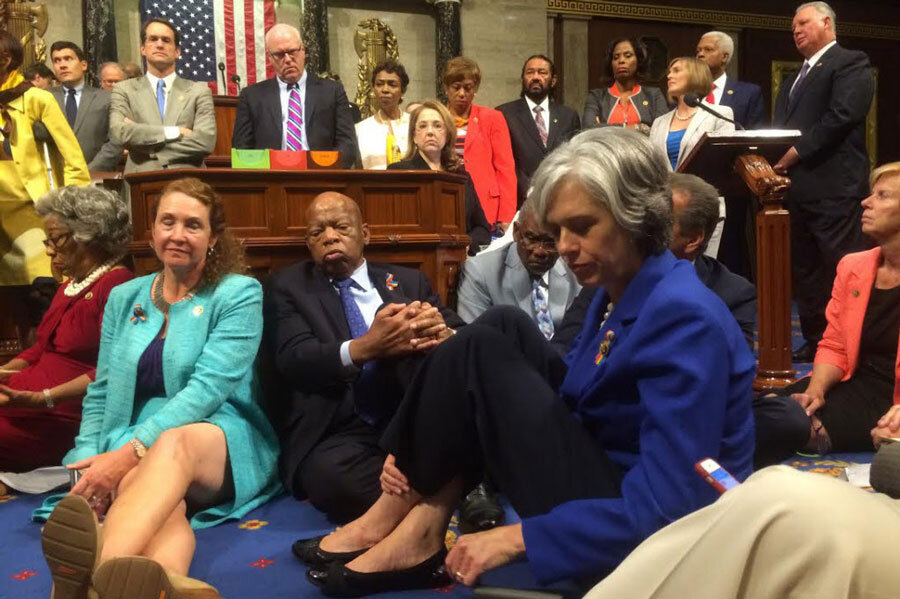Democrats sit in: Treading a line between leadership, grandstanding
Loading...
The Democrats borrowed a page from the civil rights era Wednesday, staging a sit-in on the floor of the House of Representatives in a demand for a vote on gun control.
"We're calling on the leadership of the House to bring common sense gun control legislation to the House floor," said Rep. John Lewis of Georgia, the civil rights icon who led the sit-in, which started at about 40 members and grew as the day went along. "Give us a vote. Let us do our job. We came here to work."
It is a rare move in modern politics – one that's only been tried twice since the 1970s, once in 1995 by Democrats and once in 2008 by Republicans. The sight of lawmakers in suits sitting on the blue-carpeted floor of the House – depending on one's political perspective – either represented an outpouring of frustration by lawmakers who say they are unable to sit idly by after yet another mass shooting or the theatrical grandstanding increasingly emblematic of a polarized system.
One party's bold leadership was the other party's stonewalling tantrum.
The fact that elected lawmakers are, in their own House, resorting to tactics ordinarily employed by the oppressed is perhaps not surprising in the toxic stew of the 2016 election season. But political observers were wary of both the tactic and what it might portend.
"Sit-ins are righteous when they're the tool of an oppressed minority group insisting on equal rights," writes Conor Friedersdorf on The Atlantic's live blog. "But members of Congress are among the most powerful political actors in the country, and they are acting on an issue that is endlessly discussed and debated, not one that requires unusual tactics, like subverting order in the national legislature, to air all sides of the matter. When Republicans respond to not getting their way by undermining legislative norms, the press objects. It should object here."
But others, including two presidents, extolled the event as necessary in an age when the normal wheels of governance appear permanently stalled on the issue of gun violence.
"Thank you John Lewis for leading on gun violence when we need it most," President Obama tweeted.
"This is leadership," former President Bill Clinton wrote.
The protest comes as federal lawmakers have struggled to craft a legislative response after the murder of 49 people in a mass shooting at a gay nightclub in Orlando, Fla., on June 11— the worst terrorist act in the US since 9/11. Sen. Chris Murphy (D) of Connecticut led a 15-hour filibuster on the Senate floor last week calling for the chamber to vote on gun control legislation. The Senate voted on four bills on Monday. None passed.
Sen. Susan Collins (R) of Maine is working on another gun control proposal, but nothing has yet been proposed in the House.
House Speaker Paul Ryan has not yet committed to a vote, according to spokeswoman AshLee Strong.
"The House cannot operate without members following the rules of the institution, so the House has recessed subject to the call of the chair," Ms. Strong said in an e-mailed statement.
The sit-in has been broadcast mostly on social media as C-SPAN's cameras, controlled by the Republican majority, have been switched off most of the afternoon, with many Democrats using the hashtag #NoBillNoBreak. The social media video service Periscope created a channel dedicated to the protest.
With its direct action tactics, and the involvement of Lewis, the demonstration has provoked comparisons to the civil rights movement. Lewis organized sit-ins at segregated lunch counters in the 1960s, and joined Martin Luther King Jr. in civil rights marches in Selma, Ala., and the 1963 March on Washington. Lewis told NBC News that "sometimes you are moved by history."
Some Republicans, for their part, referenced history in their criticism of Wednesday's sit-in.
"Calling this a sit-in is a disgrace to Woolworth's. They sat-in for rights," Rep. Mark Walker tweeted. "Dems are 'sitting-in' to strip them away."
As the day went on, some Democratic senators brought snacks to their colleagues, while others, including Senator Murphy, Sen. Bernie Sanders (I) of Vermont, and Sen. Elizabeth Warren (D) of Massachusetts, joined the sit-in.
“This is an extraordinary tactic,” Murphy said, adding, “This is an exceptional time.”








